- Where is Russia's Largest Arctic Port?
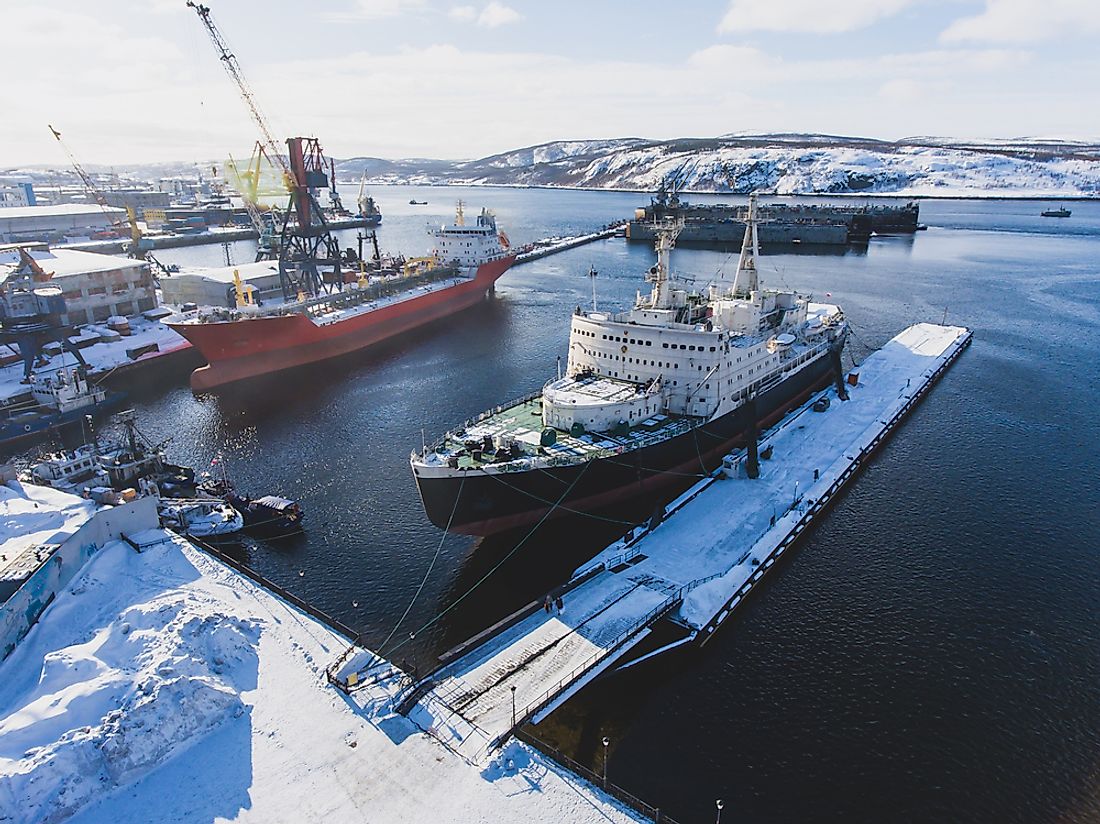
The city of Murmansk is an Arctic port city in northern Russia. Murmansk is located along the Kola Bay. Kola Bay is an inlet that leads to the Barents Sea. This Arctic city is part of the Kola Peninsula. The latitude Murmansk is located at is 68°58'N, 2 degrees north of the Arctic Circle. The population of Murmansk is 299,148 people. This makes Murmansk the largest city north of the Arctic Circle.
Murmansk's importance as an Arctic port comes from having in ice-free harbor despite its Arctic location. Ocean currents give Murmansk an ice-free port. Not only is it Russia's largest Arctic port city, it is the largest Arctic port city in the world. It is a large city for its location because of transportation geography. Its own transportation geography, as well as the decline of Arctic sea ice, is a reason it is sought after as a hub for transportation on the Northern Sea Route.

Murmansk, An Ice-Free Arctic Port
How does a large city exist so far north? The answer to this question originates in the Gulf of Mexico. This is where the Gulf Stream originates. The Gulf Stream is an ocean current that flows from the Gulf of Mexico towards the northern Atlantic Ocean. This current becomes the North Atlantic Drift and flows past northern Europe and towards the Kola Peninsula in Russia. Despite the subarctic climate of Murmansk, the waters near Murmansk generally remain ice-free. The North Atlantic Drift aids in keeping those waters ice free for the most part.
It was the ice-free waters of Murmansk that would lead to this city being founded. During World War I, it was important to have a port to ship military supplies from. A railroad was constructed, spanning from Petrozavodsk to Kola Bay. With ice-free waters, a port was built on Kola Bay, and Romanov-on-Murman (now called Murmansk) was founded in 1916. Today, Murmansk is home to Russia's largest Arctic port. It is also the home of the only nuclear icebreaker fleet.
Northern Sea Route Aspirations
Murmansk stands out from many port cities in the Arctic region. Cities such as Barrow, Alaska and Iqualuit, Nunavut, are often isolated. Murmansk is more connected than other Arctic cities. Highways and railroads connected Murmansk to the rest of Europe.
Murmansk is also located along the Northern Sea Route. As Arctic ice melts in increasingly larger amounts, the Northern Sea Route is becoming more and more attractive for shipping. Shipping companies in South Korea are particularly interested in the Northern Sea Route. South Korean container ships often go through the Suez Canal to reach Europe. The Northern Sea Route is a shorter route to Europe. A transportation hub is being planned in Murmansk. A new railway is currently being built as part of the new hub. Murmansk being well-connected to the rest of Europe and having an ice-free port is why it is being chosen as one of two hubs along the Northern Sea Route (the other one being Petropavlovsk-Kamchatskiy in the Kamchatka Peninsula). One South Korean shipping company, Hyundai, is planning trial runs on the Northern Sea Route in 2020.
- World Facts
More in World Facts

The Largest Countries In Asia By Area

The World's Oldest Civilizations

Is England Part of Europe?

Olympic Games History

Southeast Asian Countries

How Many Countries Are There In Oceania?

Is Australia A Country Or A Continent?

Is Turkey In Europe Or Asia?
- Russia Tourism
- Russia Hotels
- Russia Bed and Breakfast
- Russia Vacation Rentals
- Flights to Russia
- Russia Restaurants
- Things to Do in Russia
- Russia Travel Forum
- Russia Photos
- All Russia Hotels
- Russia Hotel Deals
- Things to Do
- Restaurants
- Vacation Rentals
- Travel Stories
- Rental Cars
- Add a Place
- Travel Forum
- Travelers' Choice
- Help Center
Is it Safe to travel Murmanskin the end of December? - Russia Forum
- Europe
- Russia
Is it Safe to travel Murmanskin the end of December?
- United States Forums
- Europe Forums
- Canada Forums
- Asia Forums
- Central America Forums
- Africa Forums
- Caribbean Forums
- Mexico Forums
- South Pacific Forums
- South America Forums
- Middle East Forums
- Honeymoons and Romance
- Business Travel
- Train Travel
- Traveling With Disabilities
- Tripadvisor Support
- Solo Travel
- Bargain Travel
- Timeshares / Vacation Rentals
- Europe forums
- Russia forum

is it safe to travel Murmanks during 26th-27th December?
I'm Indian citizen, Should i be worried about racism?
Is polar night going to cause problems in term of mugging or scamming (because it dark all day long)?
I want to see northen lights, is December end going to be a good time to spot northen lights?
How can i book train tickets from Moscow to Murmansk in advance ???

It is equally safe to visit Murmansk in December or June, no difference. As Murmansk is a major port, people have seen all kinds of races, and no racism could be expected.
As for the darkness - people live there, and streets are lit, actually the day is not completely dark, there is some light reflection, and is it magical, with white snow...
Chances for Aurora are unpredictible of course, bur December is a better time than most other months, seen several times myself around New Year's...
Surely no extra crime based on darkness.
Rail tix are sold at www.rzd.ru, 90 days from departure.
You might consider flying, as the train takes two nights; but is fun if you like train travel.

You need to worry about your warm clothes more than about crime.
@dimitriy Z: I have taken that into account, since Indian jackets aren't gonna work there, i plan to buy Jacket, Boots & hand gloves there in Moscow, I'm backpacking (budget traveler), can you give some idea about how much would that (Jacket, Boots & gloves) cost me ??? I'll be looking for cheap and best...

You'll find prices on these multinational's website:
https://www.decathlon.ru/
https://www.sportmaster.ru/
I'm a big fan of "Do It Yourself" travel style, but in your case maybe it will be better to find a local guide. Even we Muscovites are not always ready for Murmansk winter and sometimes make grave mistakes with clothes. A piece of advice from a local may be vital in your case. Besides, best places to observe auroras are outside the city, because there is too much lights in the streets.
Thanks for warning (with clothing), I've never been to any cold place before, Is there any advice you'd like to give about Moscow and St. Petersburg? about clothing or traveling or any advice would be helpful since I don't know anyone there & it's my 1st trip.. :)
Moscow and St. Petersburg are usually not very cold in December, but it does not mean warm, though. You may expect an average temperature about zero (-5...+5 C), often with rain and/or wet snow. The real cold usually begins in January, but this may vary, better check weather forecasts before your departure.
The general rule is to use more layers: a slim sweater and a t-shirt is better, than a thick sweater alone. Use thermal underwear. It is better that your jacket is waterproof, also boots. A winter hat, a scarf and gloves are the must.
BTW, if this is going to be your first trip, maybe you'd better go to some warmer place in Europe? I've recently returned from Belgrade, and there I learned, that Serbia is now visa free for Indians. Serbian winter is also cold, and they have winter activities such as mountain skiing, but still the weather there is much less extreme and more comfortable.
I disagree with the advice to go out of Murmansk to see Aurora. Been there many times and seen the wonder right in the city. There are lights, but npt really obscurring the watch. If one hoes to Murmansk for two days, let him has at least some city pleasures besides looking into the skies...
Sirely visit one ofthe mountain slopes. They have ski and snowboard rentals; if you are not up to - there is a great fun with sliding downhill on large inflated 'tyres'. Makes fun and good photos...
Thanks, I'm looking forward to enjoy Murmansk, Would love to try sking & visit few monuments, I've heard about some waterfall outside of city, I was wondering if its worth going for.?
Yes! I would defiantly prefer to watch Aurora from city itself as i'm guessing, going outside of city for aurora hunting would cost me big amount(Tour) & I'm on a budget backpaking trip
Thanks for support, I would visit as many places as i can & i hope i enjoy Poler Night & hopefully spot Aurora & most of all I hope i won't freeze to death :D :)
- I need payment help with Russian bank card 5:20 pm
- Information on Poke, Russia 1:31 pm
- Extending a Russia tourist visa in Russia? 12:47 pm
- Exchanging money late at night in St Petersburg today
- Where to stay in Novosibirsk? yesterday
- Are there direct flights from Moscow to central/southamerica May 05, 2024
- SIM card May 05, 2024
- travel to moscow May 04, 2024
- Crossing the border from Narva to Ovanograd by bus May 02, 2024
- Traveling to Russia in January 2024 Apr 30, 2024
- Travel to Russia Apr 30, 2024
- Migration Registration Apr 29, 2024
- Flights to Russia 2024 Apr 29, 2024
- Thorough immigration checks when entering Russia Apr 29, 2024
- Transaero Airlines 5 replies
- American Movies set in Russia 5 replies
- Moscow Airport transfer (SVO to DME) 4 replies
- Travel All Russia travel compnay 48 replies
- Russian River Cruise 10 replies
- Suggested Russia Tour - East West Tours 6 replies
- Do I need a visa if my flight has a connection in Russia? 4 replies
- Insight Vacations 24 replies
- Asian Grocery Store in Moscow 4 replies
- "Tourist Confirmation Letter and Travel Voucher" for a visa. 5 replies
- Where can I get initial answers to ANY question?

Wander With Alex
Wonders of the Far North: Incredible Arctic Destinations
Posted: November 14, 2023 | Last updated: February 5, 2024
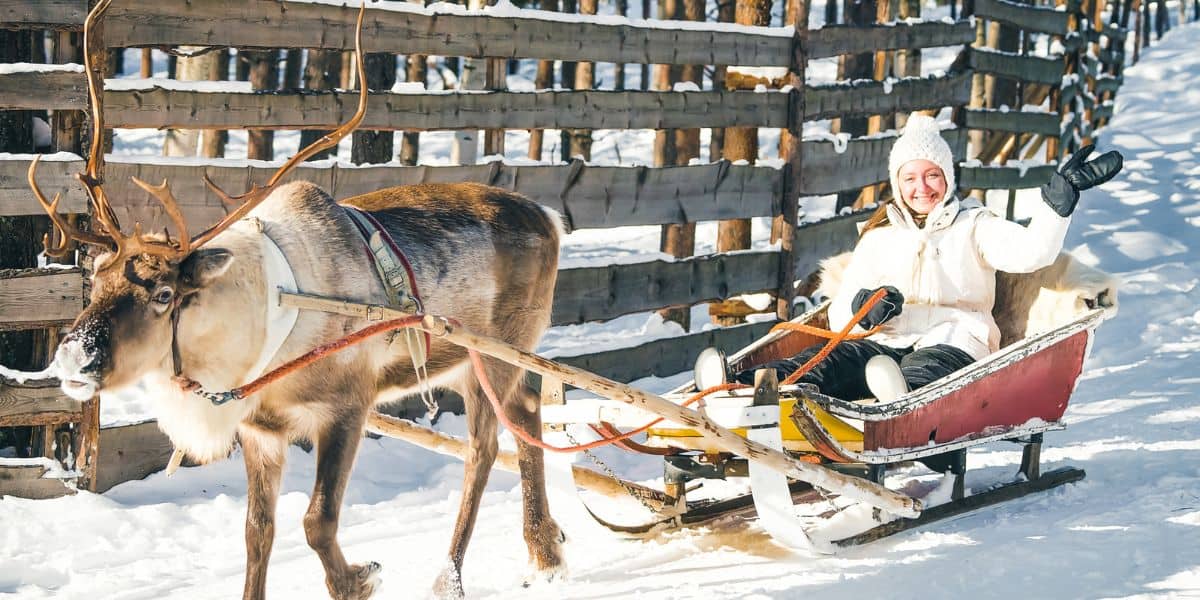
The Arctic Circle is located at the top of the Earth and is an impressive place to adventure if you love scenic landscapes and winter activities. If you cherish exploring untouched wilderness landscapes, the Arctic is full of icy terrain, massive glaciers, and wide open spaces.
Around mid-June, there is approximately one day or more when the sun remains continuously above the horizon, and there’s a time around mid-December when the sun does not rise for a day or more.
The average temperatures in the Arctic Circle vary depending on the location and the time of year. However, average temperatures are usually around -30 degrees Fahrenheit or lower in winter. Summer temperatures range from 30 to 50 degrees Fahrenheit.
The Arctic Circle is the most northern circle of latitude on Earth. It’s located at about 66 degrees 30 feet north. Countries included in the Arctic Circle include Norway, Sweden, Finland, Russia, the United States (parts of Alaska), Canada, Denmark (via Greenland), and Iceland.
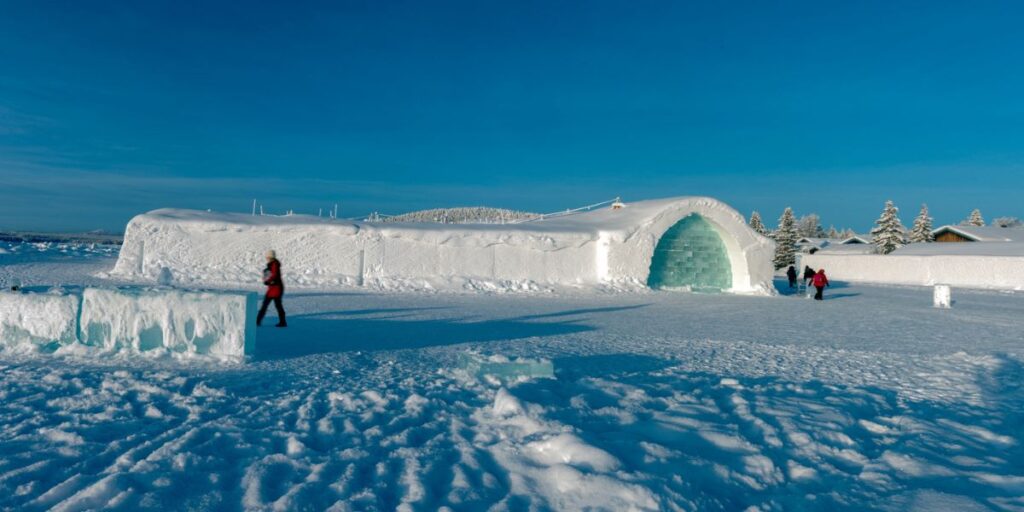
Jukkasjärvi, Sweden
Jukkasjärvi, Sweden, is a small village about 125 miles north of the Arctic Circle. Jukkasjärvi is known for its stunning display of the Aurora Borealis, its rich Sami cultural heritage, and its breathtaking Arctic wilderness that offers a range of outdoor activities.
Visitors often come to experience the breathtaking Northern Lights and partake in winter activities such as dog sledding and snowmobiling through the pristine wilderness. Summer offers the midnight sun, river rafting on the Torne River, and a chance to learn about the indigenous Sami culture. Jukkasjärvi is also famous for its ICEHOTEL , which is sculpted from ice blocks each winter.
December offers a classic winter experience featuring temperatures ranging from 8 to 18°F. For those who want to avoid the deepest cold but still enjoy the unique offerings of Jukkasjärvi, the shoulder seasons of mid-April to May and September to mid-October might be ideal.
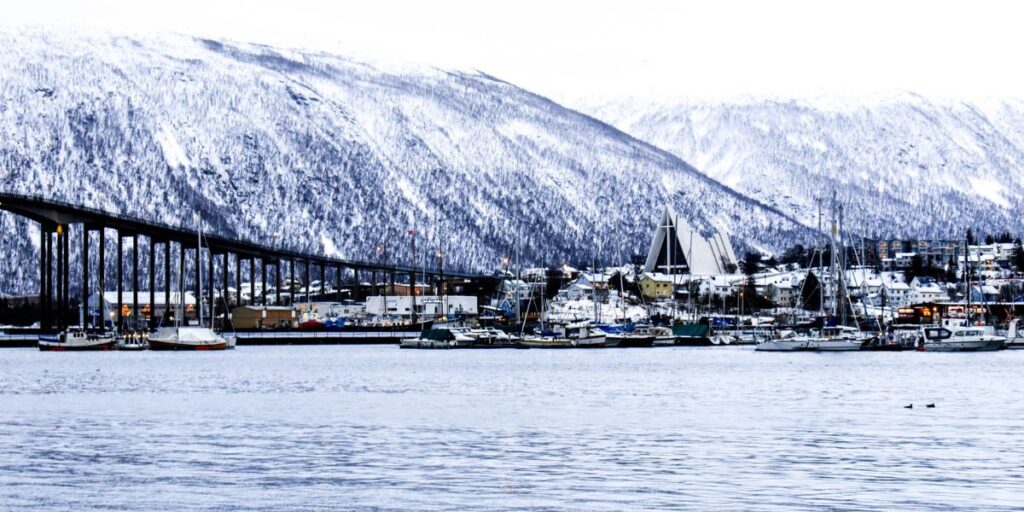
Tromsø, Norway
Known as the "Gateway to the Arctic," Tromsø, Norway, is the perfect destination for explorers looking to start their Arctic adventures and is about 220 miles north of the Arctic Circle. Many people venture to Tromsø for hunting, fishing, and seeing the Northern Lights.
Whether you prefer taking in scenic views from Mount Storsteinen via cable car or exploring the stunning Arctic Cathedral, Tromsø offers a wealth of attractions during the winter months, including Northern Lights, dog sledding through snowy landscapes, and whale watching in the fjords.
One of the best times to visit Tromsø is during the autumn months of September and October. This is a great time to catch the Northern Lights without the extremely negative temperatures that come in the dead of winter. The temperature usually ranges from the mid-30s to low 50s °F, but be sure to pack your rain jacket as there is considerable rainfall during this period.
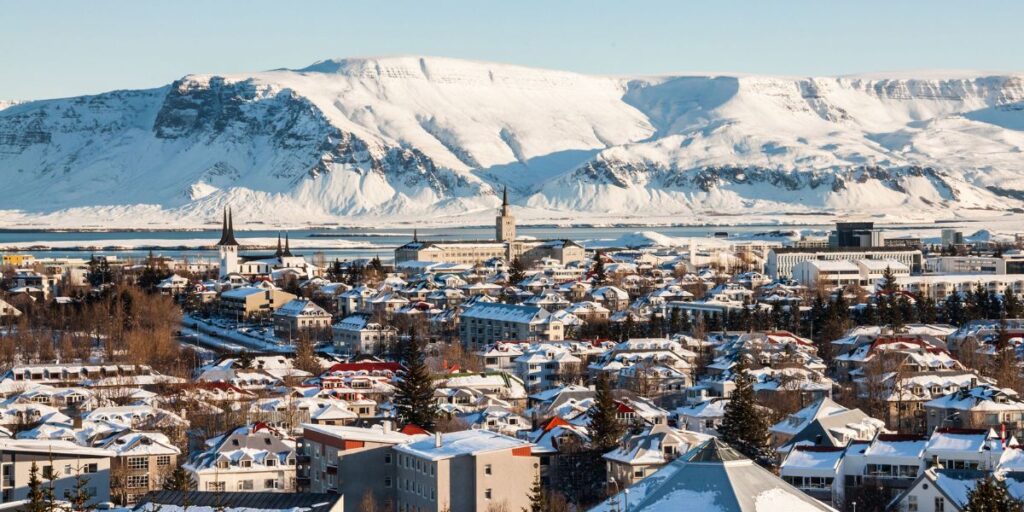
Reykjavík, Iceland
Arguably, one of the most famous Arctic Circle destinations is the capital city of Reykjavík, Iceland, which is situated about 200 miles south of the Arctic Circle. It has risen in popularity over the years mainly because of its beautiful Northern Lights, abundance of museums, and lively nightlife.
Some of the best winter activities to try while visiting Reykjavík include skiing, snowshoeing, snowmobiling, and glacier hiking. After you have finished a morning of adventures, there is no better way to relax and take in the extraordinary scenery than by relaxing in the nearby geothermal waters of the Blue Lagoon or Sky Lagoon.
If you are looking for the best time to visit Iceland during the winter months to enjoy winter sports and activities, February is a great time to explore Reykjavík. It offers excellent opportunities to witness the enchanting Northern Lights, and the Winter Festival of Lights typically occurs during this month. Anticipate temperatures ranging from the upper 20s to the upper 30s °F during this period.

Rovaniemi, Finland
Rovaniemi, Finland, the official home of Santa Claus, is a remarkable city located about 5 miles south of the Arctic Circle. It is famous for its Santa Claus Village, where visitors can visit Santa every day of the year. This festive village is full of shops, restaurants, cafes, and activities for everyone to enjoy. Experience the most popular adventures, such as dog sledding and reindeer rides. For a more exhilarating option, consider opting for a snowmobile tour.
The ideal time for a Rovaniemi visit is in December, with its iconic Santa Claus village and the opportunity to meet Santa himself during the prime Christmas season. Despite being the busiest time to visit, the magical atmosphere makes it worthwhile. Make sure to dress warmly; with temperatures ranging from 10 to 25°F, you will want to stay toasty while exploring this picturesque holiday town.
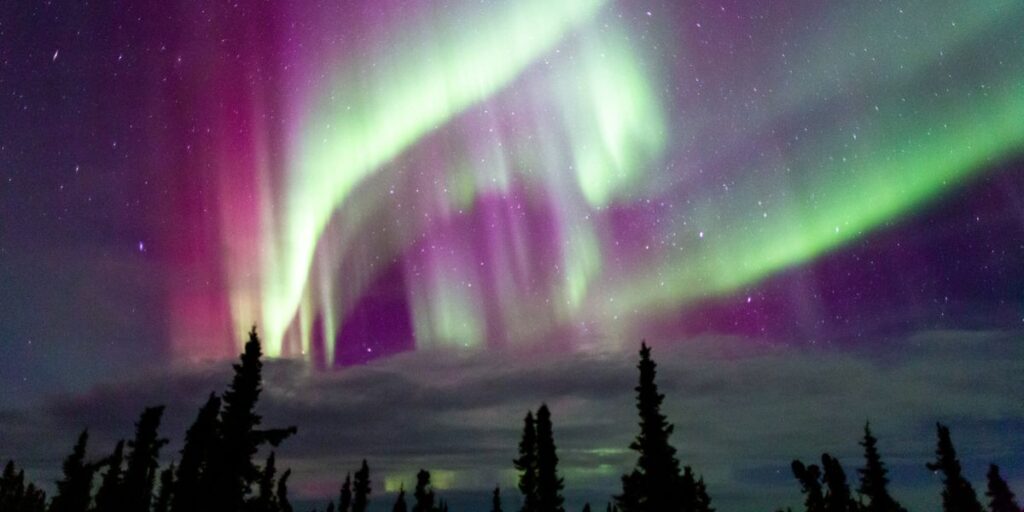
Fairbanks, Alaska
Fairbanks, Alaska’s second-largest city, is known for its stunning Northern Lights displays. The city is a captivating destination for those seeking unspoiled natural beauty within the United States and is about 200 miles south of the Arctic Circle.
Known as the Golden Heart of Alaska, Fairbanks has a deep history tied to the gold rush and has an immense Native American culture. It’s an excellent choice for U.S. citizens looking to see the Northern Lights without traveling to another country. It is also a gateway for visitors who journey to Denali National Park.
In the winter, indulge in dog sledding, Aurora viewing, snowmobiling, and ice fishing. If you would like to learn more about the Native American culture, check out the Morris Thompson Cultural and Visitor Center , where you can discover more about Alaska’s cultural roots.
The prime time to visit is during November for great views of the Northern Lights and to catch some good fish while ice fishing. The weather typically ranges from -5 to 10°F, so pack plenty of warm layers.
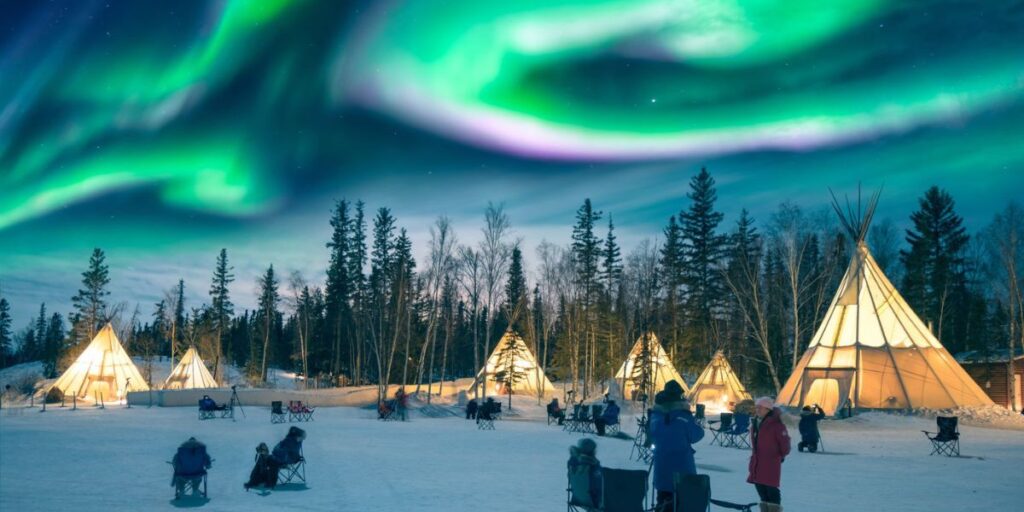
Yellowknife, Canada
Yellowknife is the capital of Canada’s Northwest Territories and is located about 250 miles south of the Arctic Circle. This old mining city is popular for its Northern Lights and indigenous culture. During the winter, there are a handful of winter activities to embark on besides viewing the vibrant Northern Lights, including ice fishing, snowmobiling, dog sledding, and snow tubing. Visiting the Prince of Wales Northern Heritage Centre is a must for those interested in indigenous culture.
The optimal time to explore Yellowknife for winter activities is in November, offering the opportunity to witness the beautiful Northern Lights and experience relatively mild weather, with temperatures usually between 5 and 20°F.
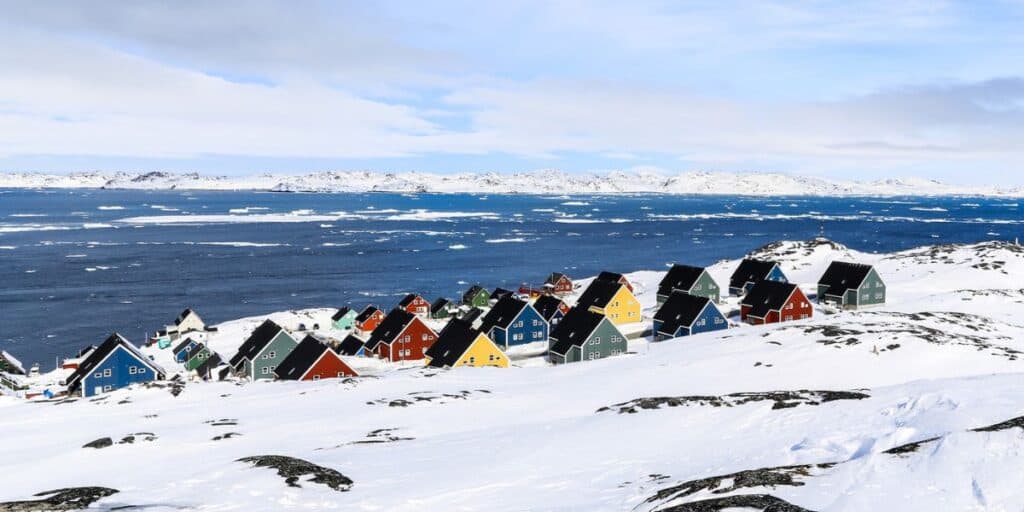
Nuuk, Greenland
Nuuk is the capital of Greenland and is famous for its brightly painted houses on the waterfront. It’s situated about 150 miles south of the Arctic Circle. This small city is known for its beautiful waterfalls, Inuit culture, icebergs, and outdoor adventure. Some of the best winter activities to embark on include snowshoeing, viewing the Northern Lights, and glacier hiking.
The best time to visit for winter activities and aurora sightings are late September and November. Within this period, the temperatures generally range from the upper 20s to the mid-40s°F.
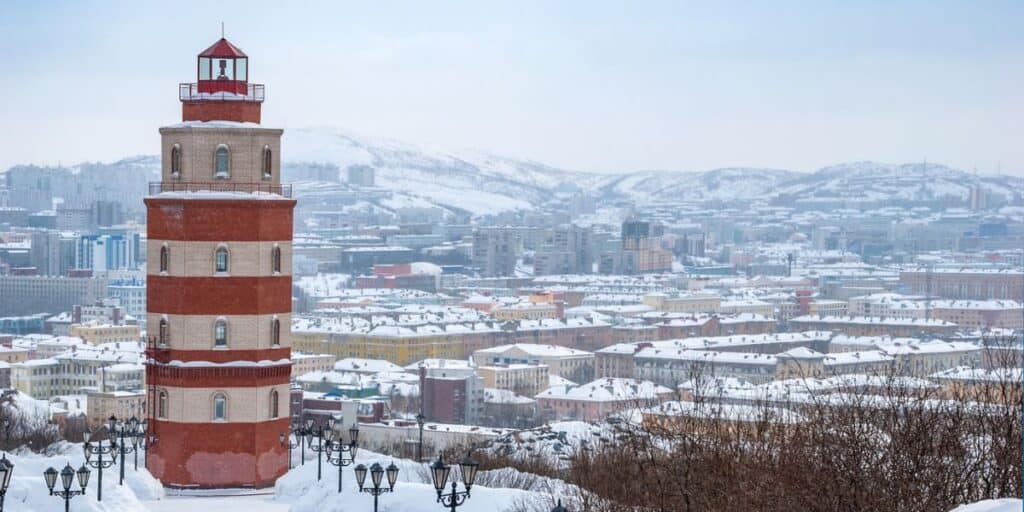
Murmansk, Russia
The large city of Murmansk is famous for being a starting point for many Arctic adventures, with numerous fishing journeys setting sail from here. This city is 125 miles north of the Arctic Circle and is popular for its gorgeous Northern Lights displays, and January is one of the best months to witness them.
January is a fantastic time to visit Murmansk, not only because of the Northern Lights but also because of the Snegoled Festival. This incredible celebration is centered around massive and intricate ice sculptures and is a must-see event when visiting during the winter season. During this timeframe, you can expect temperatures to range between 10 and 20°F.
Beyond experiencing the Northern Lights and the ice sculpture festival, visitors can participate in snow tubing and skiing activities. Another popular attraction to check out while visiting the area is the Lenin Icebreaker.
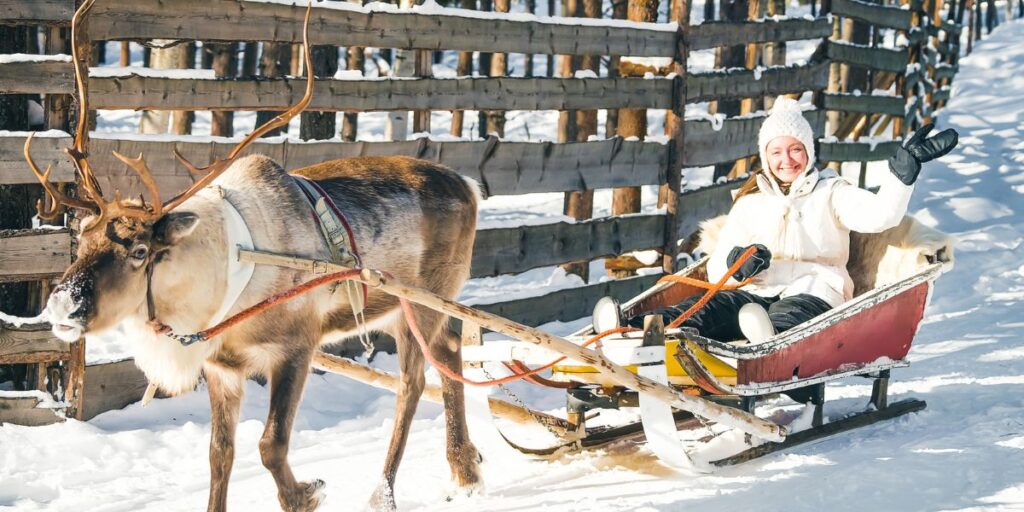
Your Arctic Vacation Awaits
Vacationing in or near the Arctic Circle offers an escape into a world of stark, haunting beauty where the sun barely rises in the deep winter. It's a place where the aurora borealis dances across star-filled skies, and the landscape is a sprawling canvas of ice, snow, and rugged mountains. The Arctic Circle is not just a destination; it's an adventure into some of the planet's most awe-inspiring natural wonders, a test of the human spirit against the elements, and an unforgettable journey into the wild.
More for You
Trump trial: Stormy Daniels tells (almost) all about alleged encounter with Trump
Best of the Roast of Tom Brady: Most Hilarious Moments Including Bill Belichick Calling Out Apple TV for ‘The Dynasty’
'American Idol' recap: Top 7 singer makes Katy Perry 'scared for my job,' and two more go home
10 best new Netflix originals you need to add to your watch list
Parents who raise successful, resilient kids never do these 5 things, experts say
25 Things That Were Considered Polite 50 Years Ago
I Lost 50lbs With 3 Lifestyle Changes
College softball rankings: 2024 NCAA Top 25 poll
Rock Queens: Recognizing 25 Women Who Shaped the Music Industry
‘We live frugally’: I’m 54 and my husband is 64. We have a $4 million net worth, but I’m not working. How should we navigate our retirement?
Map reveals best places to live in the US if nuclear war breaks out
17 Hairstyles Perfect For Older Women Who Want to Look Younger
Why Are Bullies So Mean? A Psychology Expert Explains Their Harmful Behavior
Here's How Much Electricity It Takes to Charge A Tesla
Fani Willis' Chances of Losing Primary With 2 Weeks to Election
The Best Ways to Get Rid of Ants in Your Yard
Dua Lipa Wore the Tallest Platforms We’ve Ever Seen to Perform in the Rain
Godzilla X Kong Is Now The Highest-Grossing Godzilla Movie Ever At The Box Office
Everyone Knows The SR-71 Blackbird Is Fast, But How Slow Can It Fly?
13 Polite Habits That Fast-Food Employees Secretly Dislike

Murmansk hotels
Search hundreds of travel sites at once for lodging in murmansk.
Free to use There are no hidden charges or fees.
Filter your deals Filter by free cancellation, free breakfast and more.
Millions of reviews Check ratings based on millions of real guest reviews.
Bundle and save Save money when you bundle your flight + hotel.
Best Murmansk hotels
Most recommended murmansk hotels.
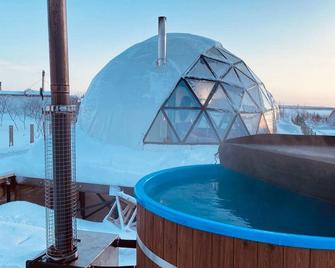
Search by stars
Search by review score, search by price, search by freebies, good to know, when to book a hotel in murmansk, top tips for finding murmansk hotel deals.
- If you’re looking for a cheap hotel in Murmansk, you should consider visiting during the low season. You'll find cheaper hotels in Murmansk in September and February.
- Hotel room prices vary depending on many factors but you’ll most likely find the best hotel deals in Murmansk if you stay on a Sunday. The opposite is true for, Wednesday, which is usually the most expensive day.
FAQs when booking a hotel in Murmansk
Which freebies do kayak users look for when booking a hotel in murmansk.
KAYAK users look for a hotel in Murmansk with free breakfast.
How do I find a hotel in central Murmansk?
After you launch a hotel search on KAYAK, you can refine your research by neighborhood, which allows you to pick the central Murmansk districts. You can also do a search using the city map to choose a specific location, like Murmansk city center.
How can I find hotels near me?
Take a look at our extensive hotel map to find the best hotels near you.
Where to stay in Murmansk?
Stays in murmansk.
- Hostels in Murmansk
- Bed & Breakfasts in Murmansk
- Inns in Murmansk
- Vacation Rentals in Murmansk
Airports in Murmansk
- Hotels near Murmansk Airport
Programs submenu
Regions submenu, topics submenu, poni 2024 capstone conference, dod's gaza pier and the maritime corridor—gaza: the human toll, lessons from myanmar.
- Abshire-Inamori Leadership Academy
- Aerospace Security Project
- Africa Program
- Americas Program
- Arleigh A. Burke Chair in Strategy
- Asia Maritime Transparency Initiative
- Asia Program
- Australia Chair
- Brzezinski Chair in Global Security and Geostrategy
- Brzezinski Institute on Geostrategy
- Chair in U.S.-India Policy Studies
- China Power Project
- Chinese Business and Economics
- Defending Democratic Institutions
- Defense-Industrial Initiatives Group
- Defense 360
- Defense Budget Analysis
- Diversity and Leadership in International Affairs Project
- Economics Program
- Emeritus Chair in Strategy
- Energy Security and Climate Change Program
- Europe, Russia, and Eurasia Program
- Freeman Chair in China Studies
- Futures Lab
- Geoeconomic Council of Advisers
- Global Food and Water Security Program
- Global Health Policy Center
- Hess Center for New Frontiers
- Human Rights Initiative
- Humanitarian Agenda
- Intelligence, National Security, and Technology Program
- International Security Program
- Japan Chair
- Kissinger Chair
- Korea Chair
- Langone Chair in American Leadership
- Middle East Program
- Missile Defense Project
- Project on Critical Minerals Security
- Project on Fragility and Mobility
- Project on Nuclear Issues
- Project on Prosperity and Development
- Project on Trade and Technology
- Renewing American Innovation Project
- Scholl Chair in International Business
- Smart Women, Smart Power
- Southeast Asia Program
- Stephenson Ocean Security Project
- Strategic Technologies Program
- Transnational Threats Project
- Wadhwani Center for AI and Advanced Technologies
- All Regions
- Australia, New Zealand & Pacific
- Middle East
- Russia and Eurasia
- American Innovation
- Civic Education
- Climate Change
- Cybersecurity
- Defense Budget and Acquisition
- Defense and Security
- Energy and Sustainability
- Food Security
- Gender and International Security
- Geopolitics
- Global Health
- Human Rights
- Humanitarian Assistance
- Intelligence
- International Development
- Maritime Issues and Oceans
- Missile Defense
- Nuclear Issues
- Transnational Threats
- Water Security
The Ice Curtain: Modernization on the Kola Peninsula

Table of Contents
Brief by Joseph S. Bermudez Jr. , Heather A. Conley, and Matthew Melino
Published March 23, 2020
Available Downloads
- Download the CSIS Brief 14916kb
CSIS Briefs
The Ice Curtain: Bringing Transparency to the Arctic is an ongoing collaborative series between the CSIS Europe Program and NGA.
The Kola Peninsula is the crux of Russia’s military establishment in the western Arctic, and its air and maritime capabilities are essential to Russia’s homeland defense, Arctic dominance, and global power projection capabilities. Russia’s modernization and expansion efforts at Severomorsk-1 air base, Gadzhiyevo submarine base, and Okolnaya submarine support base have significantly improved Russia’s operational readiness and its ability to control the surrounding maritime space in the Arctic. The Kola Peninsula is also home to systems such as the RS-24 YARS, located at the Plesetsk Cosmodrome, which pose a significant challenge to U.S. and allied defense systems. Russia’s willingness to use its arsenal of ballistic and cruise missiles to defend its position in the Arctic was on display during the Grom-2019 exercise. The expansion of Russia’s military presence in the Arctic is far from over—Russia will continue to deepen its military presence in the Arctic to protect Russian strategic interests well into the future.

INTRODUCTION
Russia’s western Arctic features a great concentration of advanced conventional capabilities for defensive and potentially offensive purposes centered on the Kola Peninsula and serves as home to Russia’s Northern Fleet headquarters, which hosts Russia’s most advanced Arctic land, air, and naval assets, notably including its nuclear arsenal and second-strike capabilities. The peninsula’s location—a gateway between the Arctic and the North Atlantic—and its extensive military assets make it central to Russia’s homeland defense and power projection capabilities. Russian military modernization efforts and new construction on the Kola Peninsula have centered around the refurbishment of air bases and expansion of naval bases. Severomorsk-1 air base, Gadzhiyevo submarine base, and Okolnaya submarine support base are particularly important because they expand and Russia’s defenses while ensuring Russia’s freedom of navigation and air sovereignty. Neighboring sites, such as the Plesetsk Cosmodrome, located at the Kura Missile Test Range in Arkhangelsk, enhance Russia’s Arctic military capabilities, as the recent Grom-2019 exercise demonstrated. The Plesetsk Cosmodrome is a particularly noteworthy site for testing advanced weapons such as the RS-24 Yars ICBM. Military exercises and weapons testing in and around the Kola Peninsula is frequent and reveals Russia’s operational readiness to engage its nuclear forces to deter adversaries in a potential conflict. Exercises such as Ocean Shield and Grom-2019 also demonstrate Russia’s calculation that the Arctic is a critical domain to its national security, power projection capabilities, and economic interests. Russia’s modernization and expansion efforts will likely continue on and around the Kola Peninsula well into the future, with the ultimate aim of asserting Russian sovereignty across the region.
MODERNIZATION OF SEVEROMORSK-1 AIR BASE
Located on the southern outskirts of Severomorsk and approximately 15.5 km northeast of Murmansk on the Kola Peninsula (Murmanskaya Oblast) is the Severomorsk-1 air base. Severomorsk-1 dates to World War II, when it was known simply as Severomorsk air base, protecting the Soviet Union’s northern flank and providing air protection for both navy facilities on the Kola Peninsula and Allied supply convoys destined for the port of Murmansk. 1 During the Cold War, Severomorsk-1’s strategic importance increased, along with that of its two sister air bases, Severomorsk-2 and Severomorsk-3. Strategic bomber (e.g., Tu-16/-95), strike (e.g., Su-24), and patrol aircraft (e.g., Il-38) based or staged at the bases were tasked with protecting the Soviet Union’s northwestern Arctic flank and providing strategic strike capability against the United States. With the collapse of the Soviet Union in 1991, the serviceability and capabilities of the Severomorsk air bases declined precipitously.
The strategic importance of Severomorsk-1 reemerged, however, during late 2011 or early 2012. During that time the Russian military began an extensive multi- year modernization project of the base in advance of the Russian Defense Ministry’s 2013 announcement that it was reengaging in the Arctic to guard its northern approaches, protect mineral and energy resources, and monitor shipping on the Northern Sea Route (NSR). 2 Since 2014, the air base has fallen under the command of the Northern Fleet. 3
Satellite imagery of Severomorsk-1 (69.030776 N, 33.42271 from May 14, 2012 shows that the base ceased to be operational as the modernization project was underway. Noticeable developments include:
- The concrete on the main runway and taxiways had been removed and the sub-surface was being graded.
- All operational aircraft had been moved to other air bases (likely Severomorsk-2 and -3).
- The remaining non-operational retired aircraft awaiting parts recovery and scrapping had been concentrated along the southwest side of the base in abandoned revetments, with 18 aircraft visible.
- The helicopter servicing and storage facility (also used for parts removal and scrapping) in the southwest corner remained operational, with at least 67 helicopters of several types and in various states of repair.
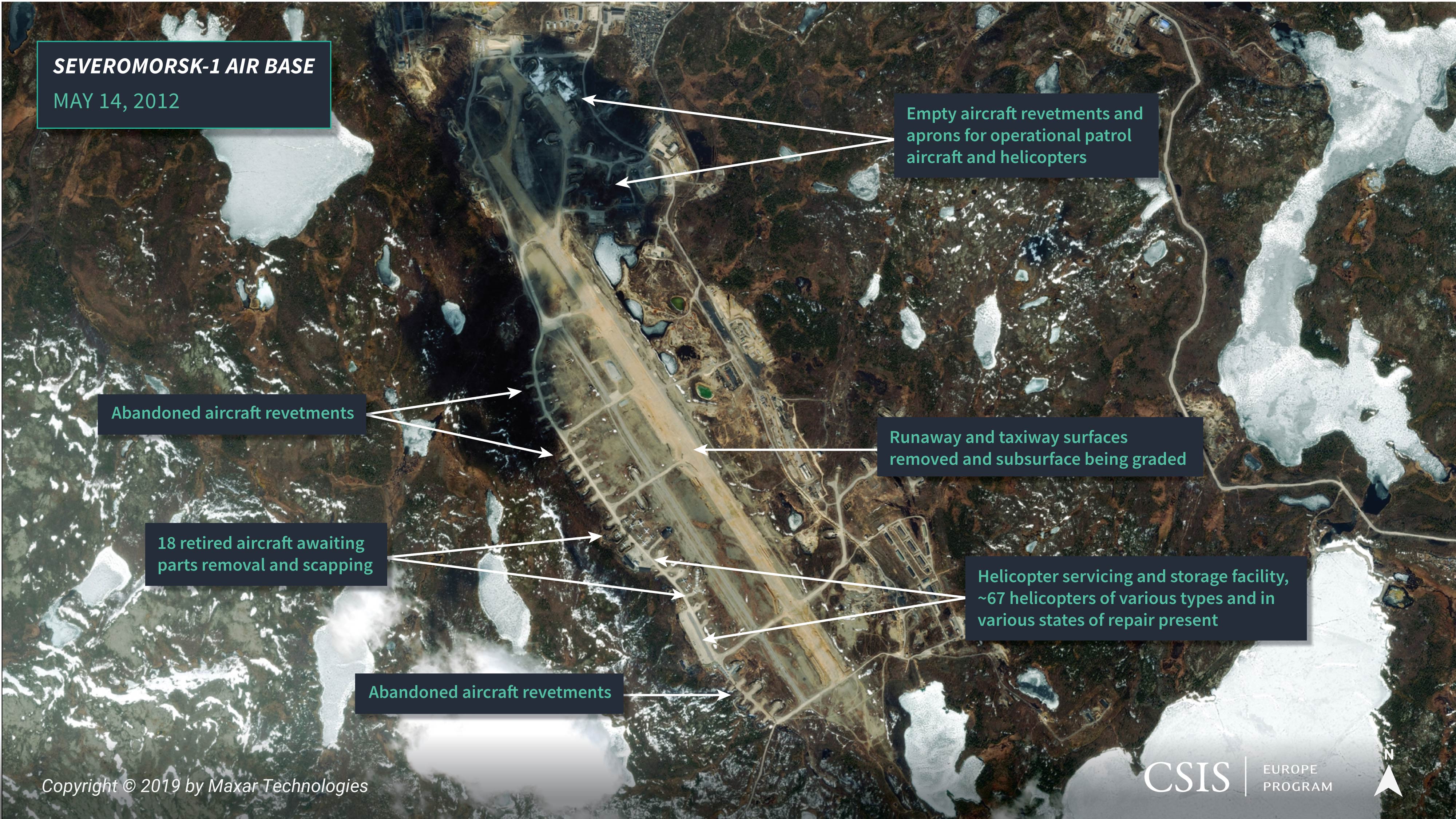
Five years later, on July 30, 2017, satellite imagery shows that considerable, albeit very slow, progress was made:
- While the base was still not operational, the paving of the 3,500-meter-long runway appeared to have been finished.
- Several new taxiways were under construction.
- The revetments and parking aprons for operational aircraft at the north end of the runway had been completed.
- The infrastructure for the instrument landing system (ILS) was under construction.
- The 18 retired aircraft awaiting parts recovery and scrapping that were previously in abandoned revetments on the southwest perimeter had been repositioned to an unimproved taxiway in the center of the air base.
- The number of helicopters at the helicopter servicing and storage facility declined to approximately 53 of several types and in various states of repair.
- Many of the previously abandoned aircraft revetments had been razed.
More recently, a September 4, 2019 satellite image shows that while the air base has once again become operational, the modernization project is not complete, as much of the work on parts of the infrastructure (e.g., completion of taxiways and aprons) remains to be completed. Among the indications that the base is operational include:
- Patrol and transport aircraft and helicopters were deployed on aprons and in revetments at the north end of the runway.
- A transport aircraft was present on the taxiway leading to the runway.
- Tire tracks from landings were visible on either end of the runway.
- The taxiways and aprons have continued to be slowly expanded.
- The number of helicopters at the helicopter servicing and storage facility have continued to decline, with approximately 36 of several types and in various states of repair being present.
- Only 12 of the approximately 18 retired aircraft awaiting parts recovery and scrapping remained. Several of which showed recent signs of being disassembled (e.g., wings sections laying on the ground).
Throughout this modernization, minor improvements have been undertaken among the air base’s supporting infrastructure, including housing, warehouses, machines shops, and support areas on the north side of the base.

However, the modern Murmansk-BN electronic warfare (EW) system, which had been reported as being deployed in the Severomorsk area, was not readily identified in the area immediately around Severomorsk-1 in the most recent satellite image. 4 Given the relatively slow pace of construction observed during the past seven years, it is unclear when the entire modernization project will finally be complete.
Upgrades to Severomorsk-1 increase Russian operational readiness, presence, and capabilities in the northwest Arctic region, particularly improving domain awareness and operational capacity around the Kola Peninsula. Increased numbers of patrol aircraft tasked for search-and-rescue operations improve the viability of the NSR as a maritime commercial route. With further upgrades to the base, operational capacity could expand further into the Barents Sea, Greenland Sea, North Atlantic, and an increasingly ice-free Arctic Ocean. In anticipation of receding ice and increased human activity in the Far North, Severomorsk-1 can deepen Russia’s strategic reach and propel its forward line of defense further from its coastline, enhancing anti- access/aerial denial capabilities near the Kola Peninsula. If the Murmansk-BN EW system is deployed (none of the satellite imagery currently shows the Murmansk-BN system), it would further bolster Russia’s Arctic capabilities by improving safety along the NSR and providing early- warning capabilities. With a reported range of 5,000- 8,000 km , Russia could theoretically monitor and disrupt communications across the entirety of the NSR and Scandinavia as well as deep into the Central Arctic Ocean. In May, the Northern Fleet reportedly completed its new Center for Radio-Electronic Warfare, which will oversee systems on Severomorsk. The Murmansk-BN and complimentary EW systems add another layer to Russia’s defense capabilities on the Kola Peninsula, potentially disabling foreign ships, submarines, or aircraft traveling toward the eastern entrance of the Russian Arctic. These EW assets would essentially render an intruder “ deaf, numb, and blind .” Russia’s EW capabilities were on display during NATO’s Trident Juncture 2018 exercise, when both Norway and Finland were the victims of Russian GPS jamming and interference, an increasingly important tool used frequently by Russia.
NEW MISSILE STORAGE FACILITY AT OKOLNAYA SUBMARINE SUPPORT BASE
The Okolnaya submarine support base (69.095773° 33.450602°) is located on the eastern shores of Guba Okolnaya (Okolnaya Bay), Murmanskaya Oblast, and serves as one of several strategically important Russian Navy submarine bases and submarine-launched ballistic missile (SLBM) storage and loading facilities on the Kola Peninsula. Other SLBM loading facilities include the Gadzhiyevo submarine base and Severodvinsk submarine base. 5 In addition to housing and maintaining SLBMs, Okolnaya likely stores nuclear warheads. While most often described as a submarine support base, it likely also supports the cruise missile requirements of other Northern Fleet surface combatants, such as the warships based across the bay at the Severomorsk navy base. The Okolnaya submarine support base has been associated with nuclear-armed SLBMs since the late-1950s. As a historical footnote, the base appears to have played a minor but important role during the 1962 Cuban Missile Crisis, when nuclear weapons may have been transported from Okolnaya to Cuba and back again during October-November 1962 by the merchant vessel Aleksandrovsk . The voyage of the Aleksandrovsk was unique in several ways: it was the only merchant vessel known to have carried missile-related equipment from Cuba to the Soviet Arctic, and it was one of the first to depart after the Soviet decision had been made to remove strategic weapons from Cuba. The vessel may have carried nuclear warheads to and from Cuba, perhaps without ever having offloaded them. By transferring nuclear warheads via this Arctic facility, the Soviets probably hoped to avoid any possible radiological monitoring or surveillance in either the Danish or Turkish Straits,” underscoring the importance of the Arctic as an avenue of approach to the United States. 6 During 2013, media reports indicated that the Okolnaya submarine support base would be expanded by the construction of a large storage facility for “. . . more than 100” RSM-56 Bulava SLBMs (NATO reporting name: SS-NX-30 or SS-N-32). The Bulava equips the Project 955/955A Dolgorukiy-class (also known as Borei-class) nuclear-powered ballistic missile submarines (SSBN), each of which can carry 16 missiles. The Dolgorukiy-class SSBNs are expected to eventually replace the Delta III- and Delta IV-class SSBNs currently in service with the Northern Fleet. 7 The location chosen for the new storage facility (69.114642° 33.525728°) is 3.7 km northeast of the main Okolnaya facilities on the site of an old open storage facility that consisted of 14 large revetments, several support buildings, and a large parking area. Satellite imagery shows that by May 2014 construction started and that by August 2015 there were a total of 31 weapons storage bunkers under construction (none of which were completed), with excavations underway on others. 8 By July 30, 2017, the number of bunkers completed or under construction rose to 38, and construction of what appears to be a triple fence security perimeter began. 9

Most recently, in satellite imagery from September 4, 2019, there are a total of 41 weapons storage bunkers (35 completed and 6 under construction) and excavations underway for at least 9 more. Additionally, there are several new small support buildings, and construction work on the triple fence security perimeter appears to slowly continue. Media reports indicate that construction of the facility is scheduled to be completed during 2020, and given the current rate of progress, and barring unforeseen circumstances, this projected date appears feasible. 10 All of the storage bunkers observed to date consist of an approximately 40-meter-by-32-meter concrete structure that is protected on three sides by earthen berms, with an approximately 52-meter-by-20-meter concrete pad on the fourth open side and a final 75-meter-by-18- meter protective berm in front of it. Thus, each storage bunker occupies a footprint of approximately 75-meters- by-90-meters. Internally, each bunker consists of fourapproximately 20-meter-by-32-meter storage bays. Adjacent to all the weapons storage bunkers is a smaller auxiliary bunker of varying sizes for unidentified purpose (potentially for power and environmental controls). It is assumed that when completed the facility will consist of a total of 50 storage bunkers, each with four storage bays, with the potential to house a total of 200 RSM-56 Bulava SLBMs, corroborating media reports from 2017. 11 While almost all media reports describe the new storage facility as being for nuclear-armed RSM-56 Bulava SLBMs, there is nothing to prevent sensitive non-nuclear munitions (e.g., cruise missiles) from also being stored. It is also likely that aside from ballistic and cruise missile support, the base provides other submarine-related support services. Likely in support of the larger role of the RSM-56 Bulava SLBMs stored at Okolnaya, and the slowly increasing number of Dolgorukiy-class SSBNs in the Northern Fleet, a second missile loading facility was built during 2012-2018. 12
NEW MISSILE STORAGE FACILITY AT GADZHIYEVO SUBMARINE BASE
The Gadzhiyevo submarine base (69.258878° 33.335251°) is located on the eastern shore of Guba Sayda (Sayda Bay), Murmanskaya Oblast, and serves as one of several strategically important Russian Navy submarine bases and SLBM storage and loading facilities on the Kola Peninsula. 13 It reportedly is the primary home port for the Northern Fleet’s Project 667BDRM Delfin (Delta IV) and Project 955/955A Dolgorukiy-class SSBNs. 14 As such, the base not only houses and maintains the R-29MU2 Liner (NATO reporting name: SS-N-23) SLBMs for the Delta IV and RSM-56 Bulava (NATO reporting name: SS-NX-30 or SS-N-32) SLBMs for the Project 955/955A Dolgorukiy-class SSBNs but also the nuclear warheads they support. The base may also support the cruise missile requirements of Northern Fleet surface combatants.
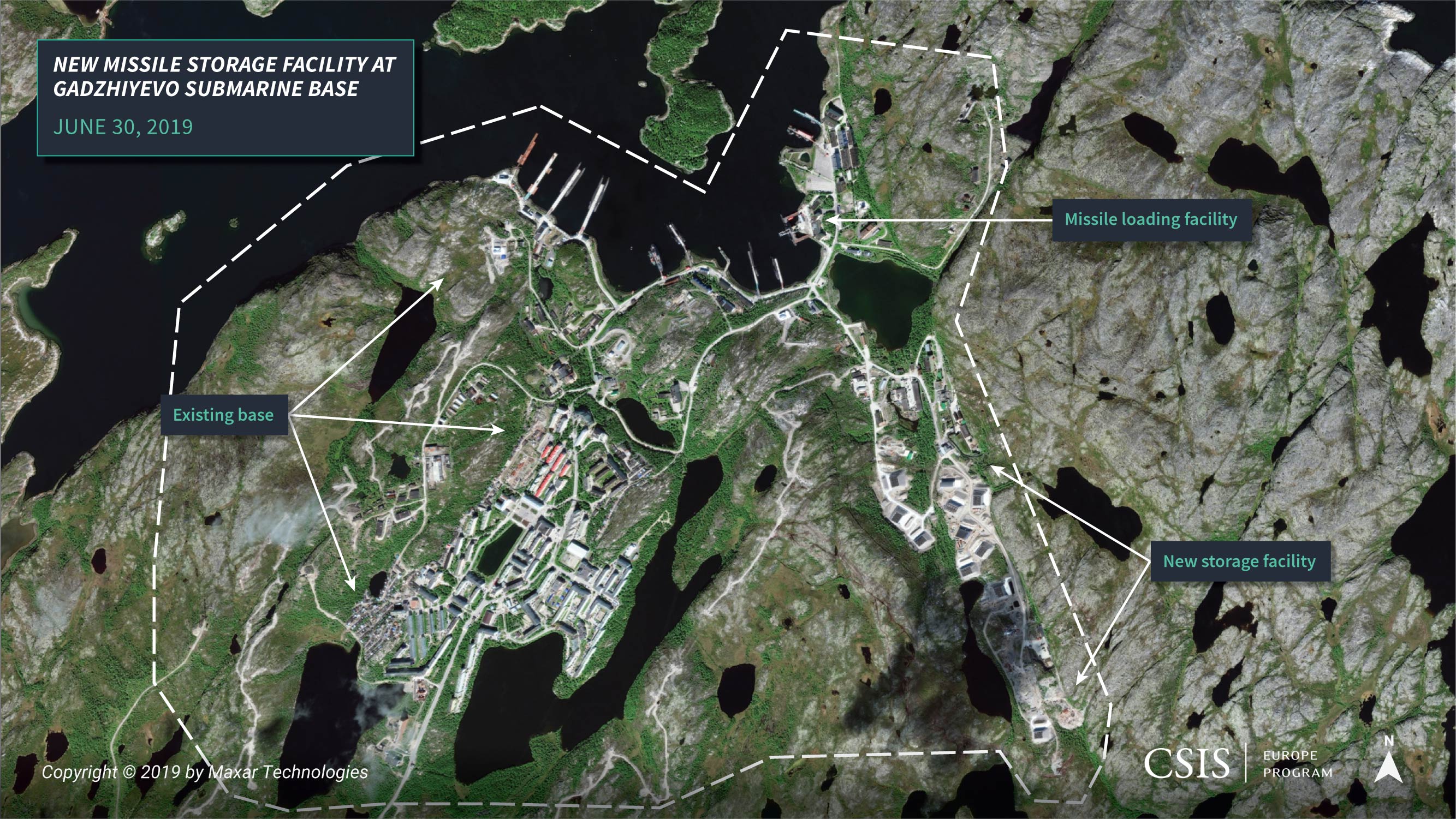
During 2013, media reports indicated that the Gadzhiyevo submarine base would expand to include the construction of a new SLBM storage facility. 15 The location chosen for the new storage facility (69.251165° 33.357418°) is one kilometer south of the main Gadzhiyevo facilities on the site of an existing storage facility. The existing facility consists of several vehicle maintenance and storage facilities and yards, bunkered storage facilities, open storage yards, and a number of support buildings. All but the bunkered storage facilities and open storage yards would be retained for the new facility. Satellite imagery shows that construction had started by May 29, 2014 and that there was a total of three weapons storage bunkers under construction, with excavations underway for others. By May 23, 2016, the number of bunkers under construction (none of which were completed at the time) rose to 10, and excavation work for a new support building began. Most recently, satellite imagery from June 30, 2019, shows that there is a total of 10 weapons storage bunkers with 5 completed and 5 under construction. Space within the existing storage facility remains for additional storage bunkers should the Russians decide to build them. Media reports suggest that construction of the facility is scheduled to be completed during 2020 to coincide with the launch of the eighth Dolgorukiy-class SSBN. 16 Given the current rate of progress, and barring unforeseen circumstances, this projected date appears feasible. All of the storage bunkers observed to date are similar to those built at the Okolnaya submarine support base and consist of an approximately 40-meter-by-32-meter concrete structure that is protected on three sides by protective berms, with an approximately 55-meter-by-20-meter concrete pad on the fourth open side and a final 65-meter- by-20-meter earthen berm in front of it. Thus, each storage bunker site occupies approximately a 90-meter- by-80-meter footprint. Internally, each bunker consists of four approximately 20-meter-by-32-meter storage bays. Adjacent to all the weapons storage bunkers is a smaller auxiliary bunker of varying sizes for unidentified purposes (potentially for power and environmental controls). At present, there are a total of 10 storage bunkers, each with four storage bays, which would imply that the facility has the potential to house a total of 40 RSM-56 Bulava or R-29MU2 Liner SLBMs, although most reports state that they will be used for the nuclear-armed RSM-56 Bulava. Regardless, there is nothing to prevent sensitive or non-nuclear munitions (e.g., cruise missiles) from also being stored here. Unlike the Okolnaya submarine support base, no second missile loading facility has yet to be built at the Gadzhiyevo submarine base.
Russia’s 2017 updated Naval strategy elevated the role of its maritime forces in securing Russia’s Arctic domain. The strategy builds on President Putin’s promise in 2010 to spend more than 20 trillion rubles to modernize 70 percent of all Russian military equipment by 2020. Under this modernization plan, Russia’s naval forces are a priority, harkening back to the Cold War when Soviet maritime capabilities posed a formidable challenge to NATO. Upgrades at Gadzhiyevo and Okolnaya reinforce defensive and offensive capabilities around the Kola Peninsula. Naval bases housing Delta IV-class and Dolgorukiy-class SSBNs are a key component of Russia’s bastion defense concept. These SSBNs, when equipped with SLBMs, are the backbone of Russia’s sea-based component of its nuclear triad. Importantly, the SSBNs represent Russia’s second- strike capabilities and serve as a deterrent against potential adversaries. The Dolgorukiy-class in particular boasts improved stealth capabilities as well as increased SLBM payload, adding to Russia’s “ defense in depth ” of the Kola Peninsula. Stealthier submarines such as these enhance the regime’s survivability and pose a challenge to NATO’s sea lines of communication in the North Atlantic as NATO is increasing its anti-submarine warfare capabilities. While the primary objective of the SSBNs is defensive, they also serve as a tool of power projection beyond the Kola Peninsula. Admiral James Foggo, commander of Allied Joint Force Command Naples, warned about Russia’s renewed capabilities in the North Atlantic and the Arctic. Of particular concern is the ability of Russian submarines to project power through the Greenland-Iceland-United Kingdom (GIUK) Gap. In October 2019, NATO tracked 10 Russian submarines south of Iceland testing their stealth abilities and demonstrating their capacity to threaten the strategic maritime route between the United States and Northern Europe. The exercise also exposed Russia’s ability to break out into the North Atlantic and threaten the east coast of the United States. Russia’s defense of its western Arctic territory is determined by its ability to control the surrounding maritime space and assert its presence in maritime choke points like the Greenland-Iceland-United Kingdom-Norway (GIUK-N) Gap. To this end, Gadzhiyevo and Okolnaya are critical staging grounds and house Russia’s most advanced capabilities.
PLESETSK COSMODROME: TESTING RS-24 YARS ICBMS DURING GROM-2019
Between October 15-17, 2019 Russia held its annual Grom (Thunder) strategic nuclear forces exercise (Grom-2019). Among the elements that participated in the exercise were units from the Strategic Rocket Forces, Long-Range Aviation, Military Transport Aviation, and Russian Navy. Included within the exercise was the launch of a road-mobile RS-24 Yars (NATO reporting name: SS-29 or SS-27) ICBM from the Plesetsk Cosmodrome, in Mirny, Arkhangelsk Oblast, at the Kura Missile Test Range, originally known as Kama, in Kamchatskiy Kray (eastern Russia). 17

On October 3, 2019, just 12 days before the start of the Grom-2019 exercise, a satellite image was collected of the Plesetsk Cosmodrome. This image covered what is reported to be “Launch Complex 158” (63.008134° 41.551304°), 52 km east of the main facility. 18 The complex encompasses approximately 148,350 square meters and is surrounded by a security fence. The site’s launch pads, single-bay garage, and support buildings occupy a T-shaped area lying on a generally east-west axis. The maximum east-west width is 365 meters and maximum north-south height is 240 meters. Visible in the October 3, 2019 image of Launch Complex 158 are two RS-24 Yars ICBMs resting on their MZKT- 79221 16x16 Transporter-Erector-Launchers (TEL). These TELs are positioned, one apiece, on the complex’s east and west launch pads. Also visible are several support vehicles on the east launch pad and additional support vehicles in the complex’s parking area. From ground imagery released by the Russian Defense Ministry, the TEL at the western launch is the one that subsequently conducted the training launch during the exercise. 19 The TEL at the east launch pad was likely present as a backup in case of mechanical issues. It is unknown from which of the five reported rocket divisions these two RS-24 systems came from.
The RS-24 YARS is an ICBM capable of carrying multiple thermonuclear warheads. It has an estimated range of 10,500 km , allowing Russia to escalate a regional conflict to a global context. The system is a cornerstone of Russia’s land-based nuclear deterrent, and its road-mobile delivery system increases its survivability. Other factors, including the missile’s ability to maneuver during flight, deploy active and passive decoys, and its reported seven minute launch time, pose significant challenges to U.S. and allied missile defense systems. Russia exercised both its strategic and tactical nuclear forces during Grom-2019. The exercise included naval assets from all four Russian fleets, showing the extent to which Russia will mobilize across its military districts to defend its Arctic interests. As other analysts have noted , Grom highlighted Russia’s willingness to defend its Arctic territory with a growing arsenal of ballistic and cruise missiles. It also demonstrated the extent to which Russia has already integrated intermediate-range and shorter-range missiles in its nuclear strategy in light of the uncertain future of arms control. 20 Grom also offers insight into Russia’s evolving nuclear doctrine. Major General Evgeny Ilyin described the exercise as one where the preservation of borders and the sovereignty and territorial integrity of the Russian Federation is threatened, thus warranting the use of nuclear weapons. President Putin noted in October 2018 that Russia would only use nuclear weapons when the country is “under attack.”
The Kola Peninsula is the centerpiece of Russia’s military establishment in the western Arctic, and its air and maritime capabilities are essential to homeland defense, Arctic dominance, and global power projection capabilities. The concentration and range of multi-domain assets— from SLBMs and ICBMs to EW—deployed on and around the Peninsula underscores the Arctic’s strategic value to Russian national interests. As Arctic nations increase their capabilities in a more accessible Arctic and as non- Arctic nations such as China seek greater access to the Arctic, we can expect Russia’s military presence to expand to include conventional and dual-use assets. As the head of the Northern Fleet noted on December 8, “In the near future, we should expect a further increase in the military presence of the combined armed forces and, as a result, an increase in the likelihood of conflict.” Although Admiral Moiseev was referring to NATO as well as Sweden and Finland, his comment could easily refer to Russia’s military presence in the Arctic. Matthew Melino was an associate fellow with the Europe Program at the Center for Strategic and International Studies (CSIS) in Washington, D.C. Heather A. Conley is senior vice president for Europe, Eurasia, and the Arctic and director of the CSIS Europe Program. Joseph S. Bermudez Jr. is senior fellow for Imagery Analysis at CSIS. This brief is made possible by general support to CSIS. No direct sponsorship contributed to this brief.
The Center for Strategic and International Studies' Europe Program and the National Geospatial-Intelligence Agency partnership uses unclassified geospatial imagery and data to produce new, timely, and accurate reporting on Arctic construction and modernization of civilian, dual-use, and defensive infrastructure. For more info, read the Tearline Program Explainer . To read more, visit NGA’s Tearline article or download the Tearline app from the Apple Store or Google Play . This content also syndicates to the Office of the Director of National Intelligence’s website intelligence.gov , which is a transparency effort to better explain certain strategic, economic, and humanitarian IC missions to the public.
CSIS Briefs are produced by the Center for Strategic and International Studies (CSIS), a private, tax-exempt institution focusing on international public policy issues. Its research is nonpartisan and nonproprietary. CSIS does not take specific policy positions. Accordingly, all views, positions, and conclusions expressed in this publication should be understood to be solely those of the author(s). © 2020 by the Center for Strategic and International Studies. All rights reserved. Please consult the PDF for references.

Joseph S. Bermudez Jr.
Heather a. conley, matthew melino, programs & projects.
This property isn’t taking reservations on our site right now. But don’t worry, you can find tons of other nearby properties right here .
Park Inn by Radisson Poliarnie Zori
Knipovicha Ulitsa 17, 183039 Murmansk, Russia – Great location - show map
Cleanliness
Value for money
Great location!

Park Inn by Radisson Poliarnie Zori Reserve now
- Swimming pool
- Private Bathroom
- 24-hour front desk
- Key card access
- Daily housekeeping
- Non-smoking rooms
Offering panoramic views of Kola Bay, Park Inn by Radisson Poliarnie Zori is located in central Murmansk. The property features a fitness center with a sauna, plunge pool and spa bath. Rooms at Park Inn by Radisson Poliarnie Zori offer a work desk and flat-screen TV with satellite channels. You will also find an electric kettle with tea and coffee. The private bathrooms come with heated floors, hairdryer and free toiletries. Free WiFi is available throughout the property. The hotel's Poliarnie Zori Restaurant serves Russian and European cuisine. It also offers a nightclub and 2 bars, where guests can enjoy a wide range of cocktails and refreshments. Murmansk Airport is within a 50-minute drive from the property.
Couples in particular like the location – they rated it 8.3 for a two-person trip.
Distance in property description is calculated using © OpenStreetMap
- Indoor swimming pool
- Private Parking
- Airport shuttle
- Fitness center
- Tea/Coffee Maker in All Rooms
- Good Breakfast

Property highlights
Top Location: Highly rated by recent guests (8.2)
Private parking at the hotel
Loyal Customers
끖 There are more repeat guests here than most other properties.
Availability
Select dates to see this property's availability and prices
Property practices
Categories:, hotel area info, restaurants 1 restaurant on site.
- Cuisine Russian • European
- Ambience Family-friendly • Traditional • Romantic
- Dietary options Gluten-free
Amenities of Park Inn by Radisson Poliarnie Zori
- Toilet paper
- Bathtub or shower
- Free toiletries
- Electric kettle
- Live music/Performance
- Flat-screen TV
- Fruit Additional charge
- Wine/Champagne Additional charge
- Special diet meals (on request)
- Breakfast in the room
- Tea/Coffee maker
- Street parking
- Electric vehicle charging station
- Accessible parking
- Invoice provided
- Private check-in/out
- ATM on site
- Baggage storage
- Express check-in/out
- Suit press Additional charge
- Ironing service Additional charge
- Dry cleaning Additional charge
- Laundry Additional charge
- Fax/Photocopying Additional charge
- Business center Additional charge
- Meeting/Banquet facilities Additional charge
- Fire extinguishers
- CCTV outside property
- CCTV in common areas
- Smoke alarms
- 24-hour security
- Safe Additional charge
- Shuttle service Additional charge
- Smoke-free property
- Hypoallergenic room available
- Wake-up service
- Packed lunches
- Soundproof rooms
- Hair/Beauty salon
- Facilities for disabled guests
- Airport shuttle Additional charge
- Wake-up service/Alarm clock
- Room service
- Upper floors accessible by stairs only
- Upper floors accessible by elevator
- Open all year
- Pool/Beach towels
- Hot tub/Jacuzzi Additional charge
- Sauna Additional charge
House rules
From 2:00 PM
Guests are required to show a photo ID and credit card at check-in
Until 12:00 PM
Cancellation/ prepayment
Cancellation and prepayment policies vary according to accommodations type. Please enter the dates of your stay and check what conditions apply to your preferred room.
Children & Beds
Child policies
Children of all ages are welcome.
Children 4 and above will be charged as adults at this property.
To see correct prices and occupancy info, add the number and ages of children in your group to your search.
Crib and extra bed policies
Prices for cribs and extra beds aren't included in the total price. They'll have to be paid for separately during your stay.
The number of extra beds and cribs allowed depends on the option you choose. Check your selected option for more info.
All cribs and extra beds are subject to availability.
Age restriction
The minimum age for check-in is 18
Pets are not allowed.
Accepted payment methods
Cash Park Inn by Radisson Poliarnie Zori accepts these cards and reserves the right to temporarily hold an amount prior to arrival.
Billing/invoices
Official invoices (for tax/billing purposes) are available at this property for business travelers.
The fine print Must-know information for guests at this property
Please note that early check-in or late check-out are available at surcharge and upon prior arrangement.
Guests are required to show a photo ID and credit card upon check-in. Please note that all Special Requests are subject to availability and additional charges may apply.
Please inform Park Inn by Radisson Poliarnie Zori of your expected arrival time in advance. You can use the Special Requests box when booking, or contact the property directly using the contact details in your confirmation.
In response to the coronavirus (COVID-19), additional safety and sanitation measures are in effect at this property.
Food and beverage services at this property may be limited or unavailable due to the coronavirus (COVID-19).
As a result of the coronavirus (COVID-19), this property has temporarily suspended its shuttle services.
Due to the coronavirus (COVID-19), this property is taking steps to protect the safety of guests and staff. Certain services and amenities may be reduced or unavailable as a result.
In accordance with government guidelines to minimize transmission of the coronavirus (COVID-19), this property may request additional documentation from guests to validate identity, travel itinerary, and other relevant info on dates where such guidelines exist.
Spa and gym facilities at this property are unavailable due to the coronavirus (COVID-19).
A negative coronavirus (COVID-19) PCR test result is mandatory to check in to this property.
Guests must meet one or more requirements to stay in this property: Proof of full Covid-19 vaccination, a recent valid negative coronavirus PCR test, or recent proof of coronavirus recovery.
FAQs about Park Inn by Radisson Poliarnie Zori
Does park inn by radisson poliarnie zori have a hot tub for its guests.
Yes, there's a hot tub. You can find out more about this and the other facilities at Park Inn by Radisson Poliarnie Zori on this page.
Does Park Inn by Radisson Poliarnie Zori have a pool?
Yes, this hotel has a pool. See details about the pool and other facilities on this page.
What is there to do at Park Inn by Radisson Poliarnie Zori?
- Hot tub/Jacuzzi
What are the check-in and check-out times at Park Inn by Radisson Poliarnie Zori?
Check-in at Park Inn by Radisson Poliarnie Zori is from 2:00 PM, and check-out is until 12:00 PM.
How much does it cost to stay at Park Inn by Radisson Poliarnie Zori?
The prices at Park Inn by Radisson Poliarnie Zori may vary depending on your stay (e.g. dates, hotel's policy etc.). To see prices, enter your dates.
How far is Park Inn by Radisson Poliarnie Zori from the center of Murmansk?
Park Inn by Radisson Poliarnie Zori is 0.8 miles from the center of Murmansk. All distances are measured in straight lines. Actual travel distances may vary.
What type of room can I book at Park Inn by Radisson Poliarnie Zori?

Stay in the know
Error: Please enter a valid email address.
Error: Oops! An error has occurred.
Thanks! We've sent you an email so you can confirm your subscription
Personalized recommendations
We provide personalized recommendations based on your activity on our platform. If you prefer, you can opt out of this option. Opting-out only affects your current device. Adjust this setting to your preference on other devices as well.
Verified reviews from real guests.
We have more than 70 million property reviews, all from real, verified guests .
How does it work?
It starts with a booking.
The only way to leave a review is to first make a booking. That's how we know our reviews come from real guests who have stayed at the property.
Followed by a trip
When guests stay at the property, they check out how quiet the room is, how friendly the staff is, and more.
And finally, a review
After their trip, guests tell us about their stay. We check for naughty words and verify the authenticity of all guest reviews before adding them to our site.
If you booked through us and want to leave a review, please sign in first.
Check-in date
Check-out date
Save big in Murmansk
Get exclusive Booker deals by email
For a limited time only
Awesome! You're now subscribed
- Share full article
Advertisement
Supported by
Soviets' Secret Nuclear Dumping Causes Worry for Arctic Waters
By Patrick E. Tyler
- May 4, 1992
For three decades the nuclear-powered Soviet Navy and icebreaking fleet have dumped much of their radioactive waste in the Arctic, the Russian authorities now acknowledge.
The dumping, in the shallow waters of the Barents and Kara Seas, has potentially serious consequences for the Arctic environment.
At greatest risk for Norway and Russia, two of the world's biggest fish exporters, are the bountiful Arctic fishing grounds. Radioactive contamination in the shallow seas where the marine food chain begins could contaminate the fish population and endanger the industry, officials of both countries said in interviews.
Norwegian scientists who have been testing the Barents and Norwegian Seas for several years have detected no significant radioactive contamination in the water and in fish.
But the director of the nuclear energy safety authority in Oslo said waters near the dumping sites had not been tested and sunken waste containers a few hundred feet below the surface could pose a serious environmental threat over decades as they begin to leak. Russians Confirm Reports
Reports about the dumping practices were first made last fall by a member of the old Soviet Parliament who is a radiation engineer with the state company that operates the icebreaking fleet from this port. The charges became more detailed through the winter as other witnesses stepped forward after the collapse of the Soviet Union.
After meetings this month between Russian and Norwegian Government officials, the Russian environmental authorities told their Norwegian counterparts that the reports were essentially correct and that they would cooperate in what could be a huge and costly international cleanup effort.
The first scientific expedition to map the dumping sites and test for contamination is scheduled to start on July 10 and will include 20 researchers from six countries aboard a Russian ship.
"At this stage, we would like to go down to the bottom with diving equipment and really see the waste itself," said Knut Gussgard, Norway's nuclear safety director. "We would like to see whether it is barrels or parts of submarines and reactors and we would like to take measurements and samples because we are concerned about future contamination from really big sources over 10 to 100 years."
The Norwegian authorities say fish testing near Norway's waters has shown radioactive contamination that barely registers and may be attributed to historic contamination from such sources as atmospheric testing and the Chernobyl disaster. Officials Suspect Dumping Continues
Some of the worst dumping occurred in the 1960's and 1970's, but radioactive wastes were dumped throughout the 1980's.
The navy's dumping continued until last year, said Andrei Zolotkov, a radiation safety engineer in the Murmansk Shipping Company, the state enterprise that operates the nuclear-powered icebreakers. He first researched and compiled the dumping allegations while a member of the Soviet Parliament.
Other officials suspect that some dumping may still be going on, although in 1976 the Soviet Union signed an international protocol outlawing dumping in shallow seas.
One account of the dumping given to international environmental organizations by Mr. Zolotkov indicates that at least 12 nuclear reactors were disposed of in shallow gulfs off Novaya Zemlya, the large Arctic island that the Soviet Union has used as a nuclear test range since the early 1950's. A complete submarine that suffered a major reactor accident is believed to be sunk near the island, along with still radioactive sections of other submarines.
Mr. Zolotkov said in an interview that three of the reactors from the first nuclear-powered icebreaker, the Lenin, were encased in an epoxy-like substance and then blasted through the hull of the ship to the bottom of a shallow gulf off southeastern Novaya Zemlya in 1967.
The Lenin had earlier suffered a serious reactor accident. After its radioactive power plant was purged by the explosions, the ship was towed to port and refitted.
About half of the dumped reactors went to the bottom with their highly radioactive nuclear fuel still inside, according to the information collected by Mr. Zolotkov.
In addition, thousands of containers of solid radioactive wastes from the Northern Fleet and icebreakers were dumped. In cases where they would not sink, Soviet seamen were said to have cut holes in the "sealed" containers so that they would.
In 1984, Mr. Zolotkov said, a container measuring a high level of radioactivity washed ashore on Novaya Zemlya and was dumped again.
Waste water from naval and civilian reactors was dumped by special ships that diluted radioactive liquid with seawater and then discharged it through a pipe that extended below the ships' propellers.
Mr. Zolotkov said he took part in one of these dumping missions in 1974. For five days afterward, the crew found measurable levels of radioactive cesium in seawater samples in the dumping zone, he said, but officials assumed that if other nations detected the radioactivity, they would attribute it to fallout persisting from atmospheric nuclear tests or from other sources.
"Those nuclear tests served as a sort of cover for these dumping operations," Mr. Zolotkov said.
Northern Fleet officials declined requests for an interview. They granted this reporter's request to visit the main Severomorsk naval base and then canceled the visit without explanation.
The Northern Fleet operates more than 200 nuclear propulsion reactors in its ballistic missile and attack submarines, which are based along the fiords of the Kola Peninsula. Together with surface ships and naval air forces, they represent the largest concentration of former Soviet naval power.
Russian officials do not dispute the dumping accounts and some officials said in interviews here that they believed environmental investigations now being planned would bear out the allegations that are based on ships' logs and witnesses.
"No one knew the scale of the operations carried out over 25 years," Mr. Zolotkov said. "No one tried to survey all of the materials and study the consequences." For Moscow, One More Burden
The 1972 London convention on ocean dumping outlawed the disposal of high-level wastes at sea and required that nations wishing to dispose of low-level radioactive wastes do so in ocean basins at depths greater than 12,000 feet. Depths in the Barents and Kara Seas, where the Soviet dumping has taken place, range from 200 feet to 1,000 feet.
Russia has agreed that any evidence collected in the investigation will be sent to relevant authorities, but officials said there was no remedy other than international pressure to disclose and perhaps clean up the worst sites, some of which may lie in international waters.
Ivan I. Menshikov, who is President Boris N. Yeltsin's political representative for the Murmansk region, said in an interview that he applauded Mr. Zolotkov's exposure of the dumping practices.
"This is a problem created by the Government we had before and the present leadership must solve this problem," said Mr. Menshikov, a retired army colonel. Where the financial resources will come from is less certain.
The cost of cleaning up the waste sites is another expensive and complicated liability that Moscow is ill equipped to cope with as it struggles with drastic economic reforms, inflation and the general social and political chaos of the post-Soviet transition. Rusting Submarines Hold Spent Fuel
Just downstream from this icy port, dozens of rusting nuclear submarines are moored side by side awaiting decommissioning and the removal of tons of toxic spent nuclear fuel from their reactors.
The new commander of the Northern Fleet, Vice Adm. Oleg Yerofeyev, said in a meeting with Russian reporters here in mid-April that he must scrap 10 atomic submarines by 1995. He complained that the cost of cutting up each submarine was on the order of 100 million rubles, roughly $10 million at today's exchange rate.
In the last two weeks, the Russian managers of the submarine building yard at Sverodvinsk, the largest in the world, opened discussions with a Norwegian research institute, Fridtjof Nansen, seeking Western expertise and money for the decommissioning of about 50 nuclear submarines between now and the end of the decade. Russia seeks to cut the size of the fleet by a third by 1995.
"They do not have the resources and they are facing a major environmental challenge and they do not know how to handle it," said Willy Oestrang, the institute's director.
Some senior officers in the former Soviet military have asserted that the dumping charges are exaggerated and that the waste handling practices pose no long-term risk to the environment, but this assertion is under challenge by environmental organizations.
The military appears to be supporting a proposal to build a permanent radioactive waste repository on Novaya Zemlya using one or more of the shafts built for underground nuclear explosions. But Mr. Zolotkov and some of his allies in the civilian Government are trying to insure that control of any permanent storage site does not rest with the military, which they say was most involved in the illicit dumping.
"The consequences of this program reach out into the new century," Mr. Zolotkov said, "and that's why we need a modern nuclear waste facility using experts from abroad and monitored by international organizations."
Norway also showed its concern by banning the Russian icebreakers from entering Norwegian ports to take aboard tourists for $20,000 excursions to the North Pole. Norway Is Fearful Over Fish Sales
Russian civilian officials have expressed concern about the scale of the dumping, which was kept secret within military and government circles while Soviet diplomats maintained publicly that the nation's nuclear-powered fleet conducted no dumping at sea.
[ In an interview in Oslo on April 29, the Norwegian Prime Minister, Gro Harlem Brundtland, said the dumping represented a "security risk to people and to the natural biology of northern waters." ]
Norway's Defense Minister, Johan Jorgen Holst, speaking in an interview in Oslo, referred to the more immediate threat to the region's economy, saying, "If the rumor gets around that Norwegian and Russian fish are contaminated with radioactivity, we aren't going to sell many fish." The United States and many Western European countries import substantial quantities of Norwegian fish, and Russia now depends on fish exports as a critical hard-currency earner.
Practices that would shock Western environmentalists are common here. The Soviet nuclear authorities kept tons of spent nuclear reactor fuel in "floating" storage along the busy waterways of Murmansk harbor and within the corporate limits of this city of 450,000.
The toxic spent fuel remains there for three years while its high level of radioactivity "cools" enough so it can be shipped by railcar to Chelyabinsk in the southern Ural Mountains for reprocessing.
"I do not see the need for keeping spent nuclear fuel from all of the icebreakers floating in Murmansk harbor with the risk of fire and collision," Mr. Gussgard of Norway's radiation safety agency said in Oslo. "I don't think it is safe and I cannot imagine that it would be approved in any Western country."
The dumping allegations have received wide coverage in the Russian press and local political pressure has added to the demand for accountability from the navy and the icebreaker fleet. An Uneasy Public Listens to Rumors
Public revulsion over the dumping is running well ahead of the scientific efforts to verify it in detail. A longtime merchant seaman here said city residents were prone to believe the rumors that two barges containing radioactive wastes had sank while at anchor in the harbor some years ago.
Referring to the dumping allegations, Leonid B. Gurevich, the member of the Russian Parliament from Murmansk, said, "I have no doubt about this information because I know the regime I was brought up in."
Norway has registered small amounts of radioactivity in the Barents Sea for years, but has attributed this to the fallout from Soviet nuclear tests and from the explosion that released a cloud of radioactive material from the Soviet nuclear power station at Chernobyl in 1986.
But virtually no independent testing has taken place in the waters near Novaya Zemlya and in the Kara Sea, which the Soviet Navy regarded as home waters and which remained effectively closed during the cold war years.
The dumping allegations have broken the traditional military grip on this area. In a meeting with Norwegian officials in Moscow two weeks ago, Russian officials agreed to assemble the first inventory of radioactive waste sites in Arctic waters and present it to Norwegian officials in May.
Then, from July 10 to Aug. 6, scientists from Russia, Norway and four other countries will undertake an expedition aboard a Russian research vessel to locate and map dozens of underwater dumping sites. They will also take samples of the seabed and marine life to test for radioactive contamination.
An article last Monday about the dumping of radioactive waste in the Arctic by the Soviet Navy misstated the dollar equivalent of 100 million rubles, which is the estimated cost of scrapping a nuclear submarine. It is about $1 million, not $10 million.
How we handle corrections
Two Russian journalists jailed on 'extremism' charges for alleged work for Navalny group
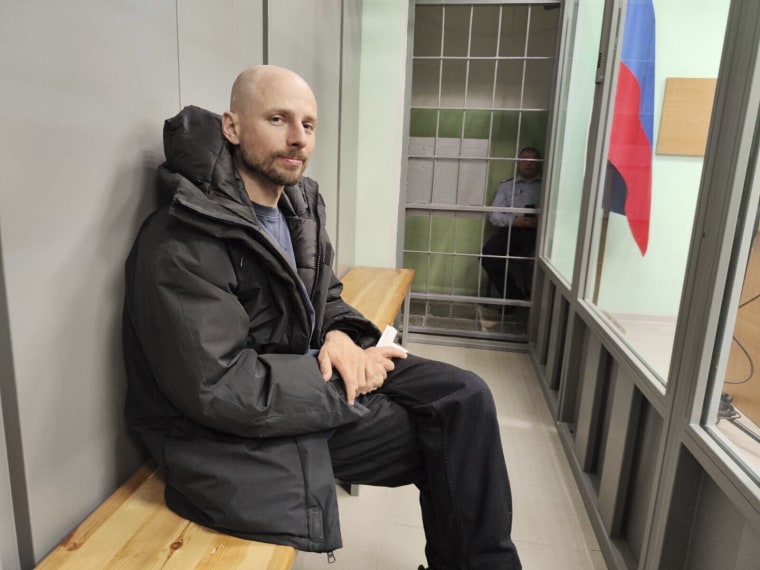
Two Russian journalists were arrested by their government on “extremism” charges and ordered by courts there on Saturday to remain in custody pending investigation and trial on accusations of working for a group founded by the late Russian opposition politician Alexei Navalny .
Konstantin Gabov and Sergey Karelin both denied the charges for which they will be detained for a minimum of two months before any trials begin. Each faces a minimum of two years in prison and a maximum of six years for alleged “participation in an extremist organization,” according to Russian courts.
They are just the latest journalists arrested amid a Russian government crackdown on dissent and independent media that intensified after its full-scale invasion of Ukraine more than two years ago. The Russian government passed laws criminalizing what it deems false information about the military, or statements seen as discrediting the military, effectively outlawing any criticism of the war in Ukraine or speech that deviates from the official narrative.
A journalist for the Russian edition of Forbes magazine, Sergei Mingazov, was detained on charges of spreading false information about the Russian military, his lawyer said Friday.
Gabov and Karelin are accused of preparing materials for a YouTube channel run by Navalny’s Foundation for Fighting Corruption, which has been outlawed by Russian authorities. Navalny died in an Arctic penal colony in February.
Gabov, who was detained in Moscow, is a freelance producer who has worked for multiple organizations, including Reuters, the court press service said. Reuters did not immediately comment on the ruling by the court.
Karelin, who has dual citizenship with Israel, was detained Friday night in Russia’s northern Murmansk region.
Karelin, 41, has worked for a number of outlets, including for The Associated Press. He was a cameraman for German media outlet Deutsche Welle until the Kremlin banned the outlet from operating in Russia in Feb. 2022.
“The Associated Press is very concerned by the detention of Russian video journalist Sergey Karelin,” the AP said in a statement. “We are seeking additional information.”
Russia’s crackdown on dissent is aimed at opposition figures, journalists, activists, members of the LGBTQ+ community , and ordinary Russians critical of the Kremlin. A number of journalists have been jailed in relation to their coverage of Navalny, including Antonina Favorskaya, who remains in pre-trial detention at least until May 28 following a hearing last month.
Favorskaya was detained and accused by Russian authorities of taking part in an “extremist organization” by posting on the social media platforms of Navalny’s Foundation. She covered Navalny’s court hearings for years and filmed the last video of Navalny before he died in the penal colony.
Kira Yarmysh, Navalny’s spokeswoman, said that Favorskaya did not publish anything on the Foundation’s platforms and suggested that Russian authorities have targeted her because she was doing her job as a journalist.
Evan Gershkovich , a 32-year-old American reporter for The Wall Street Journal, is awaiting trial on espionage charges at Moscow’s notorious Lefortovo Prison. Both Gershkovich and his employer have vehemently denied the charges.
Gershkovich was detained in March 2023 while on a reporting trip and has spent over a year in jail; authorities have not detailed what, if any, evidence they have to support the espionage charges.
The U.S. government has declared Gershkovich wrongfully detained, with officials accusing Moscow of using the journalist as a pawn for political ends.
The Russian government has also cracked down on opposition figures. One prominent activist, Vladimir Kara-Murza was sentenced to 25 years.
The Associated Press

This content requires the base game DCS World Steam Edition on Steam in order to play.

Sign in to add this item to your wishlist, follow it, or mark it as ignored
Sign in to see reasons why you may or may not like this based on your games, friends, and curators you follow.

Downloadable Content
Buy dcs: kola by orbx, about this content.
- Complete base terrain for the entire map area, with highly detailed topography, summer ground textures, shorelines, and lakes and rivers.
- An initial focus area spans the Finland/Russia border and encompasses central Finland and the western parts of the Murmansk and Karelia regions of Russia (see map).
- Four high-detail areas, focusing on two airports in Finland (EFRO, EFKE) and five in Russia (XLMV, ULAK, RU-1110, RU-4464, ULMM), and their urban and rural surroundings and infrastructure.
- Two road runways in Finland, near Rovaniemi and Sodankylä, respectively.
- Two additional airports in Norway (ENBO, ENNA) and three in Sweden (ESNQ, ESNJ, ESUK) are functional but not fully detailed at early-access release.
- Significant civilian POIs include bridges, vertical obstructions, monuments, hydro dams, power stations, port facilities, landmark buildings, open-pit mines, towns and small villages, and industrial sites.
- Improved night lighting for cities and towns.
- Main road and railroad network, with bridges and tunnels, which is connected across the map that allows long-distance AI routing.
- Natural landmarks and geographic features, like Norwegian fjords, detailed coastlines, snowfields, forests and wetlands, tens of thousands of lakes, and large river systems.
- Map features represent the current era but includes allowances for the late-Cold War era – e.g., operational road runways and fully functioning Russian air bases – to enhance mission options.
- The Orbx team is collaborating with experienced DCS campaign creators Baltic Dragon and Reflected Simulations to create engaging campaigns.
- Complete set of winter textures that load dynamically based on mission date, to accurately represent the cold and harsh climate of the Kola area.
- Additional detailed military airfields, including Andøya, Bardufoss, Kirkenes, Evenes, Vidsel, Kilpyavr, Alakkurti, and others.
- Additional military installations like naval and army bases, barracks, ports, storage areas, training areas/ranges, radar and communication sites, and air defense sites.
- Additional Cold War era Swedish and Finnish road runways.
- Additional civilian airports, including Tromsø, Hammerfest, Ivalo, Luleå, and others.
- Additional detailed cities and towns, POIs, and industrial sites.
- Improvements to landscape features and detail, as well as additional areas with high-resolution aerial orthoimagery.
System Requirements
- Requires: Digital Combat Simulator OS *: Windows 8, 10, 11
- CPU: Intel or AMD 3.0Ghz+ with 2 cores or more
- RAM: 8GB+ RAM
- Video: Discrete AMD or NVIDIA 4GB+
- DLC size: 145GB
- CPU: Intel or AMD 4.5Ghz+ with 6 cores or more
- RAM: 32GB+ RAM
- Video: Discrete AMD or NVIDIA 8GB+
All rights reserved. © Eagle Dynamics SA All rights reserved. © Orbx Systems
More DLCs from this game
Customer reviews.
You can use this widget-maker to generate a bit of HTML that can be embedded in your website to easily allow customers to purchase this game on Steam.
Enter up to 375 characters to add a description to your widget:
Copy and paste the HTML below into your website to make the above widget appear

Popular user-defined tags for this product: (?)
Sign in to add your own tags to this product.


IMAGES
VIDEO
COMMENTS
Murmansk Regional Museum of Local Lore was founded on October 17, 1926. This is the largest museum of the Murmansk region, where you can learn about the history of the region from ancient times to the present day, learn about the nature, geography and geology of our region Now our historic building in the center of Murmansk is under reconstruction, our exposition is located at the address ...
The city of Murmansk is an Arctic port city in northern Russia. Murmansk is located along the Kola Bay. Kola Bay is an inlet that leads to the Barents Sea. This Arctic city is part of the Kola Peninsula. The latitude Murmansk is located at is 68°58'N, 2 degrees north of the Arctic Circle. The population of Murmansk is 299,148 people.
Visit Murmansk. Visit Murmansk, Murmansk. 63,583 likes · 17 talking about this. We are happy to provide you a wide complex of recreational services in Murmansk region as...
It is equally safe to visit Murmansk in December or June, no difference. As Murmansk is a major port, people have seen all kinds of races, and no racism could be expected. As for the darkness - people live there, and streets are lit, actually the day is not completely dark, there is some light reflection, and is it magical, with white snow...
Visit Murman - Aurora Borealis, Murmansk, Russia. 2,210 likes · 1 talking about this · 43 were here. English-speaking team of guides will organize your trip around Murmansk region: city tour, reindeer
The large city of Murmansk is famous for being a starting point for many Arctic adventures, with numerous fishing journeys setting sail from here. ... January is a fantastic time to visit Murmansk ...
With the iPhone camera (most of the time) set to "night mode," I shot life in the darkness there. Murmansk was founded as Romanov-on-Murman in 1916 when Tsar Nicholas II sought an ice-free ...
Aurora Village Murmansk. $154+. Vash Dom Hotel Somova. $15+. Park Inn by Radisson Poliarnie Zori Murmansk. $44+. Azimut Hotel Murmansk. $35+. Koltak Hotel.
MODERNIZATION OF SEVEROMORSK-1 AIR BASE. Located on the southern outskirts of Severomorsk and approximately 15.5 km northeast of Murmansk on the Kola Peninsula (Murmanskaya Oblast) is the Severomorsk-1 air base. Severomorsk-1 dates to World War II, when it was known simply as Severomorsk air base, protecting the Soviet Union's northern flank ...
The Azimut Hotel Murmansk is a high-rise hotel in the center of Murmansk, Russia. It opened in 1984, as the Hotel Arktika ( Russian: Арктика) and was renamed the Azimut Hotel Murmansk in 2014, following major renovations. It is the tallest building in Murmansk [2] and the tallest building located north of the Arctic Circle.
Knipovicha Ulitsa 17, 183039 Murmansk, Russia - Great location - show map. Great location! Offering panoramic views of Kola Bay, Park Inn by Radisson Poliarnie Zori is located in central Murmansk. The property features a fitness center with a sauna, plunge pool and spa bath. Rooms at Park Inn by Radisson Poliarnie Zori offer a work desk and ...
On October 1, 1987, Mikhail Gorbachev gave a speech to the city of Murmansk that marked the beginning of a change in foreign policy that would be called the 'Murmansk Initiative'. [10] In the speech, Gorbachev discussed hopes for nuclear disarmament and more diplomacy with regards to the Arctic. [9]
The Soviet nuclear authorities kept tons of spent nuclear reactor fuel in "floating" storage along the busy waterways of Murmansk harbor and within the corporate limits of this city of 450,000.
Karelin, who has dual citizenship with Israel, was detained Friday night in Russia's northern Murmansk region. Karelin, 41, has worked for a number of outlets, including for The Associated Press.
An initial focus area spans the Finland/Russia border and encompasses central Finland and the western parts of the Murmansk and Karelia regions of Russia (see map). Four high-detail areas, focusing on two airports in Finland (EFRO, EFKE) and five in Russia (XLMV, ULAK, RU-1110, RU-4464, ULMM), and their urban and rural surroundings and ...